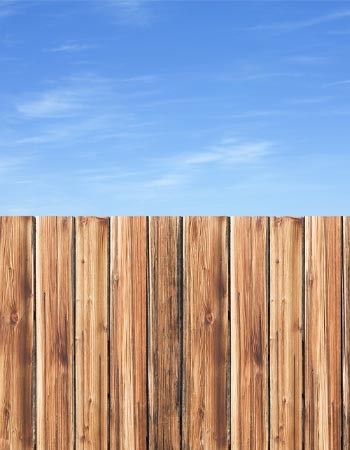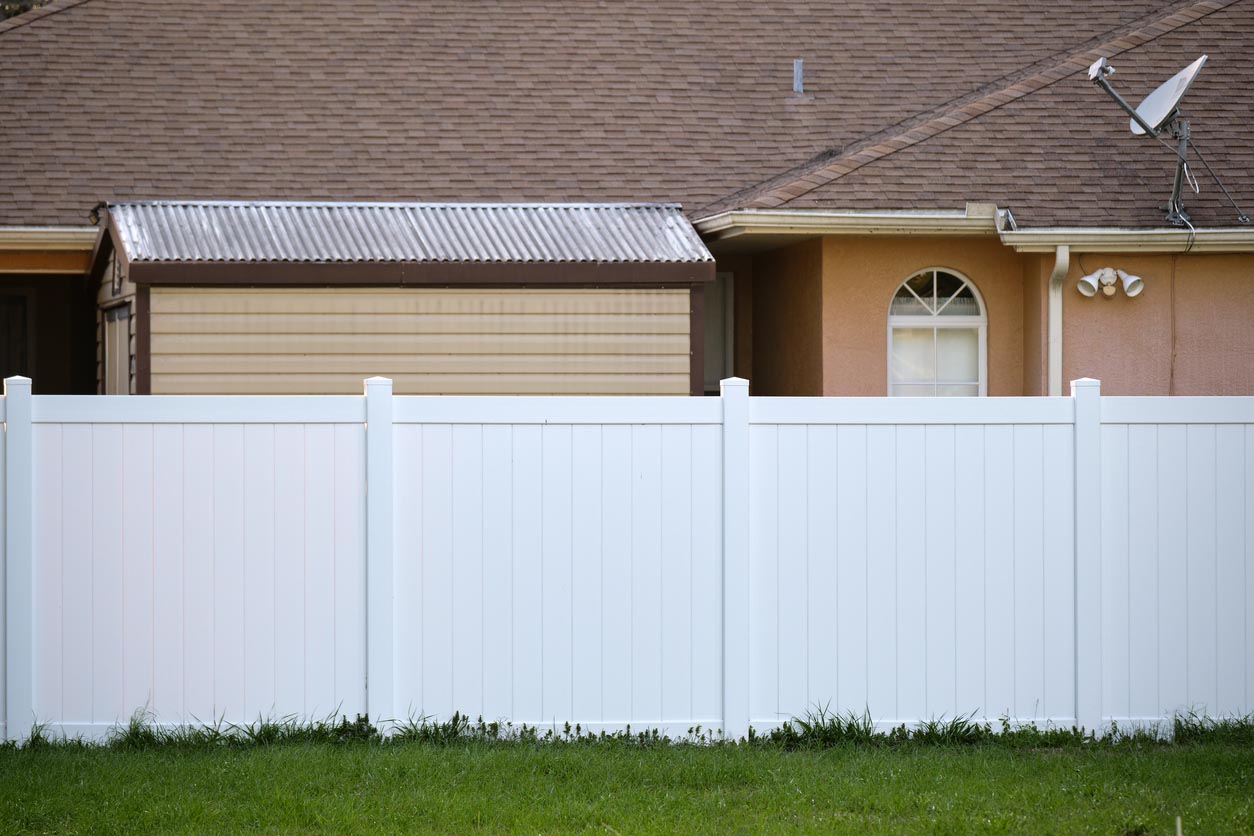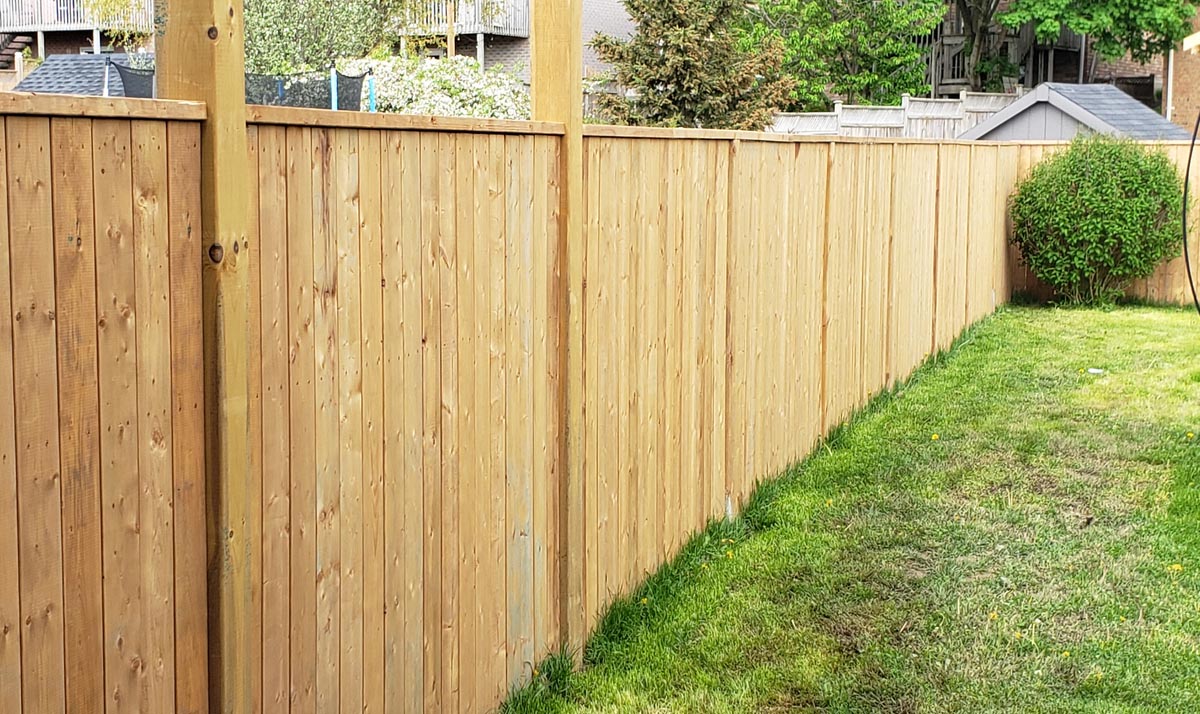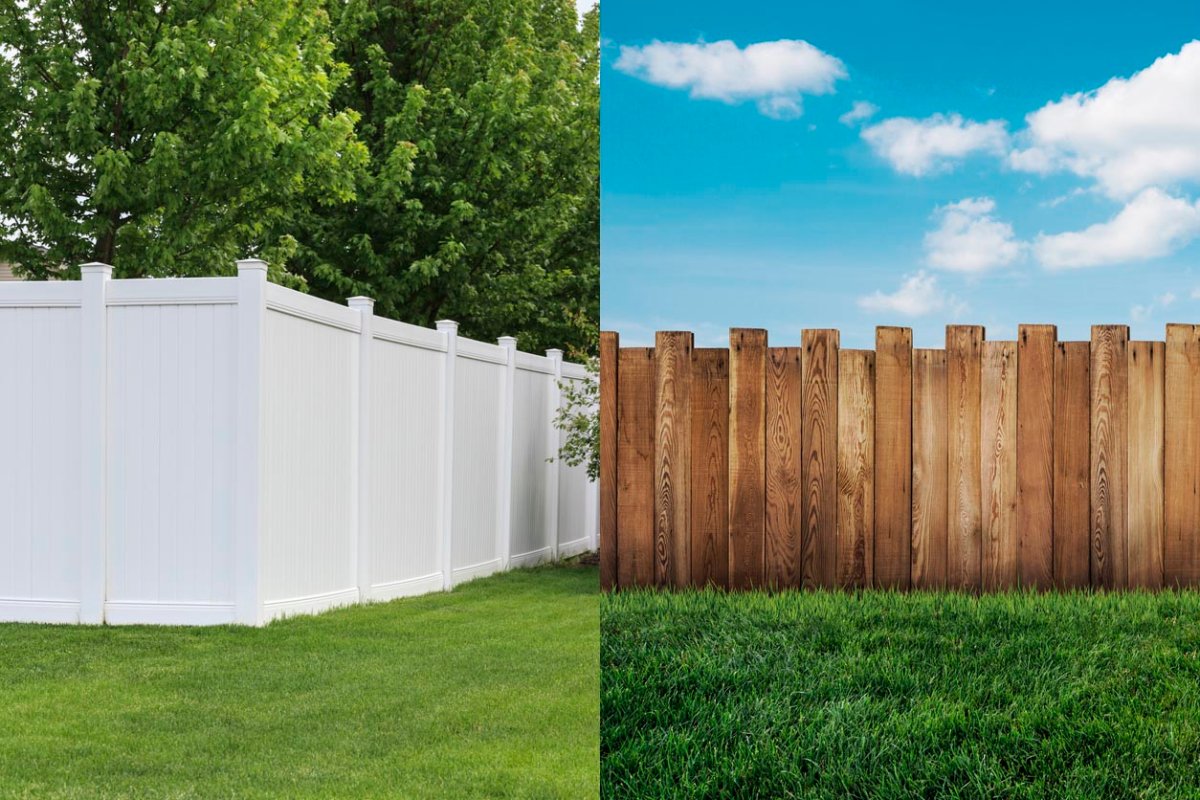We may earn revenue from the products available on this page and participate in affiliate programs. Learn More ›
Highlights
- Wood fences tend to cost less up front than vinyl fences because they have a simpler installation process.
- However, over time, wood fence costs can be higher because they require more frequent maintenance and repairs than vinyl fences.
- Vinyl fences typically have a longer lifespan than wood fences, which may make them a better investment for homeowners who plan to stay in their home long-term.
Homeowners who are looking to install or replace outdoor fencing may be wondering whether to choose vinyl fencing or wood fence panels. Both materials offer distinct advantages and have their own price points. But when it comes to prices, how do vinyl fence cost vs. wood fence costs compare?
The cost of a wood fence ranges from $1,763 to $4,416, with the national average at $3,065. Vinyl fence costs are typically higher at $2,292 to $5,799, or an average of $4,045. However, the initial cost of installing the fence is just part of the overall expense homeowners can expect to pay over the life of their fence.
1. Wood fences typically cost less than vinyl fences in installation costs.

Installation cost is a significant factor for homeowners to consider when comparing wood and vinyl fences. Wood fence installation is typically easier than vinyl fence installation, resulting in reduced labor costs and a faster installation time. Wood fence posts can be easier to set in place than vinyl fence posts. Slight misalignments in wood fencing aren’t usually noticeable, whereas with vinyl they can be easy to see.
Vinyl fencing panels are generally larger and bulkier than wood panels, which makes installing them a more intricate and time-consuming (and therefore, more expensive) process. Vinyl fence posts need to be carefully aligned and set at specific depths to ensure proper stability and appearance. This adds to the complexity of the process for fence installers and results in higher vinyl fence installation costs for the customer.
2. The exact installation cost for either fence type depends on several factors.
Although the installation cost for vinyl fence panels is typically higher than for a wooden fence, the final cost will depend on the style of fence a homeowner chooses and whether or not they opt for any add-ons.
Both vinyl fencing cost and wood fence cost can vary significantly based on factors such as the fence’s height, style, and local pricing differences. Generally, vinyl fence cost per foot tends to be more expensive than wood fence cost per foot, but the initial investment is offset by the reduced maintenance expenses associated with vinyl.
For example, a metal-and-wood fence could cost more than a basic vinyl fence. But if a homeowner is choosing between a wooden privacy fence and a shorter black vinyl fence (or another custom color), they may find that the cost to install a privacy fence is lower. Adding elements such as a wood fence gate adds an inviting touch while enhancing the security of the property, but it can also increase the total cost.
Selecting the best yard fencing for a rural property often involves considering the purpose of the fence, the terrain, desired aesthetics, and budget. Post-and-rail fencing or split rail fencing can be a popular choice for rural properties since both provide a rustic look, define boundaries, and are relatively easy to install. The cost to install a split rail fence is between $1,050 and $6,480.
3. Wood fences require more maintenance than vinyl fences, which means they have a higher long-term cost.
In addition to up-front costs, homeowners will want to consider the cost of maintaining their fence. While wood fences may have an initial cost advantage in terms of installation, the cost of maintenance over the life of the fence can be significantly more than for vinyl fences.
The natural composition of wooden fences makes them vulnerable to various environmental factors, such as moisture, sunlight, and temperature changes. Without proper care, wooden fencing can degrade over time, leading to issues like rot, warping, splitting, and insect infestation. Therefore, wood fences require frequent maintenance, including cleaning, staining or painting, and sealing, to protect them from the elements and to prevent damage. To prevent water damage, homeowners can direct sprinklers away from the fence and keep plants and bushes trimmed to avoid issues with wood rot and decay. A good cleaning with a pressure washer and one of the best deck cleaners can help get rid of mold, mildew, and dirt on the surface of the fence; this can cost between $125 and $235 depending on the size of the fence.
Vinyl fences are more durable and require less maintenance than wood. Vinyl is resistant to many of the problems that affect wood, such as rot, insect damage, and fading due to UV exposure. Vinyl fences do not require painting, staining, or sealing, which significantly reduces ongoing maintenance costs. Occasional cleaning is usually sufficient to keep a vinyl fence in good condition. While vinyl fences have a higher up-front cost, this investment can pay off in the long run due to the savings homeowners will have when it comes to maintenance.
However, extreme weather conditions or a powerful impact can cause cracking in vinyl fencing. In addition, while vinyl fences are designed to be relatively scratch-resistant, they can still get scratched under certain conditions. Although normal wear and tear is unlikely to cause significant scratching, sharp or abrasive objects could leave marks on the surface of a vinyl fence. This type of damage can vary depending on the quality of the vinyl used when building a fence.
The long-term cost of fencing is ultimately higher for wood fences than vinyl because of the additional maintenance and upkeep required to keep wood in good shape.

4. Vinyl fence repairs may cost more than wood fence repairs.
The cost to repair a fence can vary between $302 and $922, with the national average at $594. This price includes both materials and local labor costs. The total price is influenced by the style and material of the fence, the extent of the damage, the size of the fence, and the specific type of repair that’s needed.
Wood fences often need more frequent repairs than vinyl fences—especially if a homeowner hasn’t kept up with regular fence maintenance. A small repair on a privacy wood fence might only cost about $50, but repairing more significant damage could set a homeowner back as much as $2,300. The cost to repair a wood fence can also be higher if the fence is difficult to access or is built on uneven terrain.
Repairing a vinyl or PVC fence is more expensive at around $30 per linear foot. While vinyl fences are known for their durability, repairing them can be complicated. Minor holes or cracks can be fixed by using a DIY vinyl fence repair kit, but more significant damage will need the attention of a professional. Fixing holes and cracks in the material is a common repair, along with replacement of broken posts, rails, or panels. Since vinyl privacy fencing comes in large panels, it may be difficult to repair a small section, and the entire panel may need to be replaced. That can increase the cost of vinyl fence repairs significantly.
5. Wood fences have shorter lifespans than vinyl fences and will likely need to be replaced sooner.
Since wood fences are vulnerable to weather, insects, and decay, this often accelerates the need for replacement. On average, a wood fence will need to be replaced after 10 to 20 years, although some imported hardwoods, such as Brazilian walnut, can last up to 50 years with proper maintenance and care.
When it comes to wood fences, a board-on-board or shadowbox style is often regarded as the longest-lasting option. This style features overlapping boards on both sides of the fence, providing better airflow and reducing the potential for moisture accumulation, which decreases the chances of rotting. Using rot-resistant wood species, such as cedar or redwood, and performing regular maintenance can further extend the lifespan of a wood fence. The longevity of a wood fence depends on the quality of the materials, installation, and ongoing care.
Vinyl fences can last 20 to 30 years, which helps homeowners get the most out of their investment. While a wood fence might need to be replaced after 10 years, a vinyl fence can last much longer. Therefore, although vinyl fences cost more to install than wood fences, they’ll have a lower long-term cost since they won’t require replacement as soon.
While all types of fences can be repaired, sometimes a repair is not enough. If it’s time for a fence replacement, fence installation cost can range from $1,743 to $4,431 depending on the fence type, material, length, and more. Hiring one of the best fence companies or local contractors can ensure the fence is properly installed and will stand up to the weather.

6. Wood and vinyl fences can both improve a property’s value and curb appeal.
Both wood and vinyl fences can add value to a property, but the impact on value can vary depending on a few important factors.
Wood fences can contribute to the charm and character of a home, especially if they are well maintained and complement the overall aesthetic of the property. Well-constructed and visually appealing wooden privacy fencing can enhance the curb appeal of a home, potentially attracting buyers and increasing the property value.
Vinyl fences are considered low maintenance and can retain their appearance over time without the need for painting or staining. This durability and ease of upkeep can be appealing to potential home buyers, contributing to the overall value. However, some buyers may be put off by a vinyl fence if they prefer the look and feel of natural wood. Ultimately, either fence type can help improve the aesthetics and privacy of a property.
In the end, a homeowner weighing the benefits and drawbacks that come with both wood and vinyl fencing will need to make a choice between the two. Although there’s a larger initial investment for a vinyl fence, which results in reduced maintenance expenses, wood comes with less expensive up-front costs but potentially higher maintenance costs over time. Homeowners may also want to consider other options, such as chain-link vs. wood fence cost, or opt for some of the best garden fencing as a short-term solution while they decide on the best fence material for their home.


